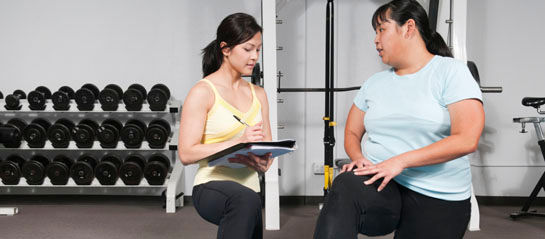
Working with obese clients can be considerably different from working with athletes. While your competitive clients may be focusing on improving their strength, power, speed and agility, your obese clients may have trouble doing simple movement patterns.
But the differences don’t stop there.
“Obese clients bring with them a set of emotional triggers involving personal, social, emotional, cognitive and physical barriers to healthy lifestyle habits,” said Dr. Michael Mantell, ACE Senior Consultant for Behavioral Sciences. “The savvy trainer knows that unless he or she first comes to understand these ‘keys’ and recognizes how to harness them for the client’s well-being, physical-activity programming is likely to fail.”
For successful trainers, that failure is not an option; after all, achieving success with one’s clients is just good business.
So, how do you adapt your approach to obese clients in a way that lets you foster rapport and put them on a path to change?
Mantell recommends these five strategies:
1. Watch Your Language—What you say to your obese clients can either help build bridges of acceptance or cause them to put up more walls of rejection. Instead of using terms like “combating obesity,” say “healing the body.” Obese, sedentary clients may feel comfortable with terms like “activity” or “movement,” but may become anxious when it comes to discussing “exercise.” Don’t focus on “losing weight,” which has a negative connotation; instead, talk about how activity will make them “feel better” or help them as their “body changes.”
2. Remember Your Audience—Your goal is to help clients make healthy changes so that they’ll feel better than they do right now. Avoid talking about how many calories they’ll burn or how much weight they can or will lose. Most likely, they don’t care about "bikini season"; they just want to be healthy and live longer.
3. Narrow Your Focus—See the gym through the eyes of your obese client. Before you start your session, make note of the size of the seat they’ll sit on while doing a shoulder lift. Is it big enough or do you need to come up with an alternative exercise? Are some of the machines so close together they’ll have trouble accessing them?
4. Be Positive—Avoid offering exercise modifications in a way that negatively emphasizes a person’s limitations. Instead of saying, “If you can’t do this, let’s try this,” say, “If you want to challenge yourself today, step it up this way.”
5. Make Them Want Change—Many of the clients you meet with are in the contemplation or preparation stages, even though they may be actively in a gym. Use that as an opportunity to help them make a decision to take action. When you hear, “I know I should make lifestyle changes, but I'm not sure I can do it,” discuss the barriers they see to change. Help your clients prioritize pros and cons to changing. Ask them, “If you decide to change, what would that change be like for you?” And “What do you like about your activity level now? What don't you like?” And finally, “On a scale from 0-10, how willing and motivated are you to change right now?”
With obesity levels reaching epidemic proportions—affecting one out of every three Americans—there is no question that understanding how to effectively reach this population is essential. Check out our upcoming ACE webinar, Epidemic Proportions: The Price of Obesity and How It’s Affected the Role of Fitness Professionals, by Natalie Digate Muth, M.D., M.P.H., R.D., on August 8 at 11 a.m. PT. Register today!